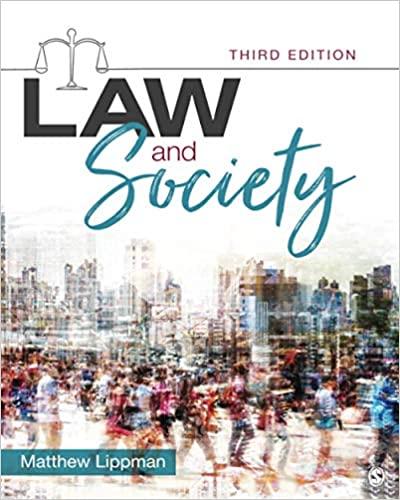Question
1. when a judge is trying to decide if a contract has been formed, the judge will look for a mutual agreement between the parties,
1. when a judge is trying to decide if a contract has been formed, the judge will look for a mutual agreement between the parties, a clear or implied intention to create a legally enforceable relationship, and a promise that something of value will be exchanged.
A. This statement is an accurate description of the essential elements of a contract.
B. This statement is not accurate because there is a contract as long as both sides agree there is a contract.
C. This statement is not accurate because the judge has more discretion than this statement implies.
D. This statement is not accurate because it is missing the element of writing.
2. I go to the grocery store. When I have what I need, I approach the checkout and wait in line. At that point, in the checkout line, which of the following elements of a contract exist?
A. Offer, acceptance, and consideration.
B. Offer, but no acceptance or exchange of consideration.
C. None.
D. Offer and acceptance, but not exchange of consideration.
3. A judge is likely to find that there is an intention to create enforceable legal relations in each of the following situations except one. Which of these situations is UNLIKELY to establish an enforceable contract?
A. You buy milk and fruit in your local grocery store.
B. You agree to do all of the dishes if your roommate does the vacuuming twice a week.
C. You accept a job with a local accounting firm.
D. You order a textbook online.
4. The law presumes that family members do not intend to enter into enforceable contracts. However, this presumption can be countered if there is evidence that
A. A family friend is also included in the agreement.
B. The family members do not like each other.
C. The family members do like each other.
D. The family members did intend to create an enforceable contract.
5. When determining whether a statement is an offer or an invitation to treat, the court will apply
A. A subjective test.
B. A reasonably subjective test.
C. An objective test.
D. The but-for test.
6 .An electronics store is having a sale on large-screen televisions. One of the items displayed has been priced incorrectly. Instead of showing a price of $1400.00, it has been priced at $140.00. You take the television to the checkout and indicate your desire to purchase the item at the advertised price. Does the store have to sell it to you at that price?
A. Yes, because it was the store that made the mistake, not you.
B. No, because consideration has not yet changed hands at the checkout.
C. Yes, because the price was an offer, and you have accepted the offer.
D. No, because the stated price is not an offer, but only an invitation.
7.Artis sends an email to Bill offering to sell an antique desk for $1450. Bill is familiar with the desk, which he previously inspected in Artis's showroom. Artis says this offer will remain open until January 18th. at 5 p.m. On January 17th, just before Bill starts to draft his email accepting the offer, Bill's phone rings. It is Artis, who says she is revoking the offer because Cathy has purchased the desk for $1600. In this situation, Bill
A. Is the lawful owner of the desk and can get a court order to take it back from Cathy.
B. Can successfully sue Artis for breach of contract.
C. Can successfully sue Cathy for inducing a breach of contract.
D. Is out of luck.
8.Richard has offered to sell you his pick-up truck for $9000. You respond by stating that you will pay him $8000 if he includes the set of snow tires and extra rims that you have seen stored in his garage. Your response will legally be considered
A. A counter-offer which kills Richard's offer.
B. A partial acceptance of Richard's offer.
C. Consideration.
D. A revocation by you of Richard's offer.
9.Jim promised to hold his offer open until February 25th at midnight. A lawyer would most likely characterize this offer as
A. An invitation to treat.
B. A standard offer.
C. An option agreement.
D. A firm offer.
10. In which way can an offeree turn a firm offer (which can be revoked) into an offer that is open for acceptance by the offeree until the designated date?
A. By accepting the offer immediately.
B. By counter-offering.
C. By selling an option.
D. By buying an option.
11. When a business sets up a tendering process, it is really making an invitation to treat, inviting contractors to make an offer to complete a particular project on specified terms, for a named price. If the tender process is set up appropriately, the business can do everything except
A. Tentatively accept the two lowest bids, then invite those bidders to sweeten the deal, then accept one of those two new bids.
B. Accept the offer of a bidder other than the lowest bidder.
C. Reject all the offers and set up a new tendering process.
D. Accept the offer of the lowest bidder.
12. Using a tendering process is an attractive option for a government agency because it allows for everything EXCEPT
A. Choosing the offer with the most attractive features, including price.
B. Demonstrating to citizens that contracts are awarded fairly.
C. Inviting offers to compete from a range of potential suppliers.
D. Exclusive bargaining with one supplier.
Step by Step Solution
There are 3 Steps involved in it
Step: 1

Get Instant Access to Expert-Tailored Solutions
See step-by-step solutions with expert insights and AI powered tools for academic success
Step: 2

Step: 3

Ace Your Homework with AI
Get the answers you need in no time with our AI-driven, step-by-step assistance
Get Started


